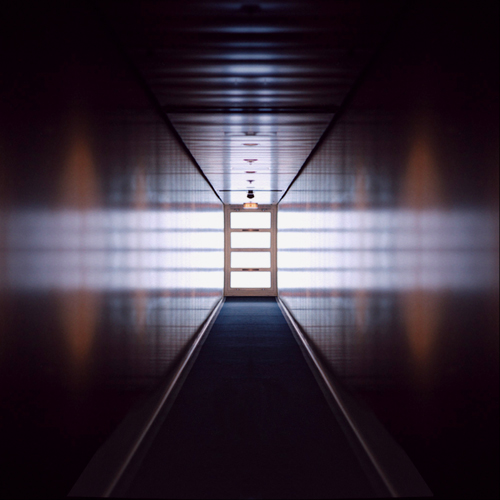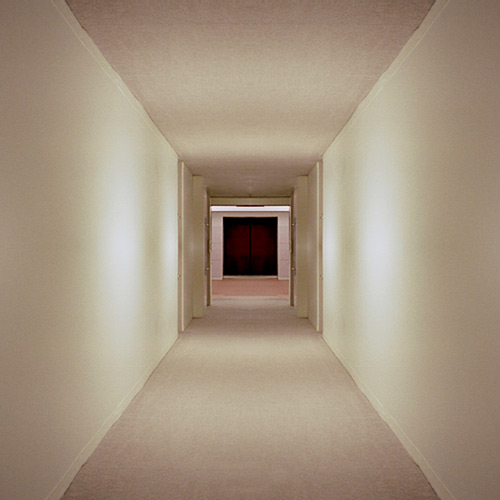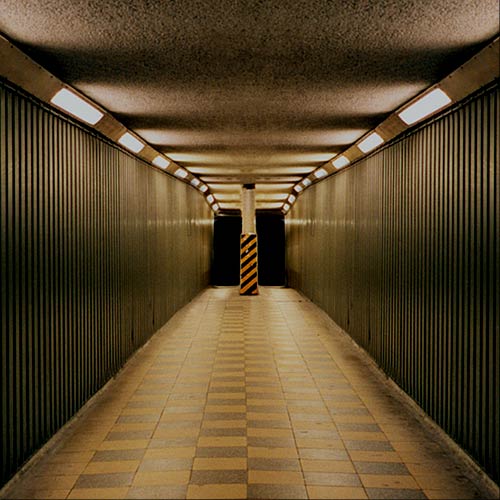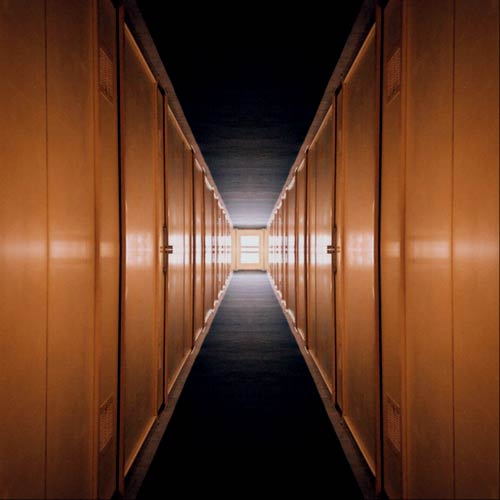New Scientist reports that certain architectural hallucinations associated with near-death experiences – such as bright lights at the end of long hallways and tunnels – might actually be the product of a sleep disorder.
 [Image: From the series Tunnel Vision, by Jill Fehrenbacher].
[Image: From the series Tunnel Vision, by Jill Fehrenbacher].
Neurophysiologist Kevin Nelson, New Scientist tells us, thinks that near-death experiences (or NDEs) “may be little more than dream-like states brought on by stress and a predisposition to a common kind of sleep disorder. If he’s right, as many as 40 per cent of us could be primed to see the light.”
But what I think deserves more exploration is the tunnel – the architectural space within which NDEs seem to occur.
For instance, is there a particular type of structure that people see when it comes to almost dying? If so, are those structures simply optical phenomena – or are there cultural and historical influences at work?
If you’re an architect, are your NDEs particularly detailed?
And what if you see a bright tunnel, inverted, ending in a space of pure darkness…?
The article doesn’t really address these issues.
 [Image: From the series Tunnel Vision, by Jill Fehrenbacher].
[Image: From the series Tunnel Vision, by Jill Fehrenbacher].
“Written accounts of NDEs go back more than two thousand years,” we learn instead, and they “have been reported all over the world. Most include a ‘point of no return’ that if crossed will lead to death, and a person who turns you away from it.”
But what about the archtecture? Does everyone see the same hallway – or do some people see large rooms, or skylights, or even underground car parks, or caves, or maybe some huge mechanical garage door that slowly creeps open…?
Is there an architecture of death?
Can it be measured and taught to others?
 [Image: From the series Tunnel Vision, by Jill Fehrenbacher].
[Image: From the series Tunnel Vision, by Jill Fehrenbacher].
If death does have a structure – or, at least, if near-death experiences do spatialize in certain pre-existing ways – if death has a spatial format, you could say – then clearly death could also be architecturally reconstructed, based on eyewitness accounts, here on earth, in the present moment, with us.
We could visit it, in groups, and emotionally prepare…
So what would happen if an architect teamed up with an anthropologist (who studies cultural narrations of the near-death experience) and with a neurophysiologist (who understands the underlying cortical mechanisms), to design themed environments specifically meant for triggering NDEs?
It’d be a kind of post-Buddhist thanatological fun ride, complete with people passing out – then waking up, blinking and vibrant, determined to change their lives, giving hugs to others and starting things over again.
Hallways of Rebirth, they might be called – and the first person to make it to the end of that hall without passing out wins $10,000.
 [Image: From the series Tunnel Vision, by Jill Fehrenbacher].
[Image: From the series Tunnel Vision, by Jill Fehrenbacher].
It’s harder than it sounds.
(All photos from Jill Fehrenbacher’s Tunnel Vision series).
Isn’t death’s spatial format Kafka’s narrow bachelor’s coffin?
Rick Strassman researched DMT in a clinical setting and speculated that the light tunnel experience in NDE narratives comes from the pineal gland releasing a burst of DMT (yes, DMT is a psychedelic both synthesized in labs and native to our brains). He links this to extraterrestrial encounters as well. His book, DMT: The Spirit Molecule, has some wild reports on alien architectures glimpsed while people were passed out on DMT…
The photos in this post remind me of the opening sequence of the classic British TV show “The Prisoner”. I guess Number Six is sort of transitioning from one life to the next as he storms down those long bureaucratic corridors en route to resigning, and then being drugged and kidnapped.
That’s funny, they remind me of several of the shots from “The Shining”. I’m not sure how Kubrick managed to make a shot of a hotel hallway ominous. I suppose it was the music that really did it.
I have read that he purposely made the floor plan of the film’s Overlook Hotel random, with no logical connection between one set and another, to create a disorienting effect on the viewer.
A New Scientist article from several months back pointed out that the vast majority of people who report Near Death Experiences actually were in no danger of dying (even without any medical assistance). Some had only fainted, which indicates that a brief interruption of oxygen is responsible for (or at least a key component of) a purely neurological event. That really kills the sexiness of it, though- after all, “The Architecture of Brief Oxygen-deprivation” doesn’t have nearly the same significance… but on the other hand, it makes a theme ride quite a bit more achievable.
holy shit! this is awesome geoff. the best ruminating you’ve done in awhile. hallways of rebirth, a spatial format for death, love it.
“but what about the architecture?” lol!
the architecture of death as you say or better still the “hallway of rebirth” exists. check out james turell’s roden crater project. by tunneling through a cinder crater he is very much refrencing the near death experience. the result is profoundly moving, no doubt a testament to the simiotics of this nearly universal perception of space.
If you are interested in near-death experiences (NDEs), you can read about them on the website of the International Association for Near-Death Studies at http://www.iands.org. In particular, you might want to check under the Research tab for published papers outlining new findings from the most current research, particularly the two articles written by medical researchers Dr. Peter Fenwick and Dr. Pim Van Lommel.
During the past 30 years, near-death experiences have been the focus of many scientific studies at universities and medical centers throughout the U.S. and around the world. Many medical professionals who have seriously studied the research – and it is extensive – no longer dismiss this phenomenon as hallucinations or caused by physiological or pharmacological factors. The best analysis of the many physiological theories regarding NDEs is on a DVD that has a presentation by Dr. Bruce Greyson (from the University of Virginia Medical School) titled “T3-Explanatory Models of NDEs.” It can be obtained from the website above by clicking the link on the home page for DVDs from the 2006 conference.
Allen
f death does have a structure – or, at least, if near-death experiences do spatialize in certain pre-existing ways – if death has a spatial format, you could say – then clearly death could also be architecturally reconstructed, based on eyewitness accounts, here on earth, in the present moment, with us.
Certain hotel lobbies tend to make me panic…the long ones with low ceilings, especially. While walking through them, I always feel the urge to run.
Very interesting post.
Not lobbies, actually…hallways.
Having had an NDE and done a bit of research I can say that “the tunnel” is not to be taken literal. The NDE is beyond human comprehension and therefore difficult to explain. NDErs often describe a rush as they leave their bodies while having a kind of tunnel vision whereby going through a tunnel is one effort of trying to describe the experience. NDErs also explain that the NDE is unlike any dream, hallucination, or illusion — in fact, the NDE is beyond any known phenomenon because it is described as “hyper real.” What people who have NDEs experience is another dimension so convincing that many studies find that 80 to 90% report significant life-changes. Most of us usually don’t change the direction of our lives simply from a dream or some illusion that we think we might have seen. Dreams, hallucinations, and illusions are either extensions of reality or destortions of reality, but NDEs are beyond reality as we know it. I would say that whether we believe that NDEs are real or not, in this unknown universe it would be arogant for anyone, including New Scientist, the deny that there is more the reality than what we know. I truely believe that NDEs are a peek beyond the event horizon into another dimension.
The Near Death Experiences have given a treasure of information on what happens after death. And the result is stunningly similar to Spiritual instructions.Read more: Near Death Experiences